Tony L
Administrator
The basic aim of this document is to illustrate what I mean when describing a record as a ‘DG tulip’ or ‘RCA black spot’ etc in my regular classical record sales - a picture is worth a thousand words, or so they say...
This is very much a work in progress and will probably grow in content / change in shape over time. I have limited the scope so far to the more collectable / interesting UK and European pressings.
Columbia:

[left to right]
1. 33CX ‘blue gold’. Columbia entered the LP market in 1952 with the mono 33CX range and this is their first label design. Many collectable titles on this label. After 1958 it ran in conjunction with the SAX stereo label with many titles appearing in each format. A good way of getting copies of fiendishly expensive SAX titles.
2. 33CX ‘red semi’. Not as common as the original ‘blue gold’ design but not as collectable either. Still nice records.
3. SAX ‘blue silver’. An exceptionally collectable label, many titles routinely achieve prices well into the hundreds and they tend to be superb sounding records.
4. SAX ‘red semi’. If a title exists on a ‘blue silver’ then the red semi issue is worth radically less. Many titles were however released on this label and can command high prices. Very nice records indeed.
5. SAX ‘postage stamp’ or ‘boxed’. The 70s variation of the label, not collectable if the recording exists in an earlier design, but still nice records.
Comments: This is the UK Columbia label, not the US one (CBS in the UK).
Decca LXT mono:

Comments: Decca’s first venture into 12” long playing records ran from 1950 through until 1969. There are actually two label designs but they are incredibly similar, the lettering print is gold on the very earliest. After the introduction of stereo in 1958 most titles were released both in mono as an LXT and in stereo as an SXL. Where both titles exist the SXL is invariably more valuable, though there is a large number of titles that ae mono only. Some are worth serious collectors prices. The LXT, like Columbia’s 33CX and HMV’s ALP ranges, can be a very good way of obtaining titles which are prohibitively expensive and collectable in the stereo format. They tend to be nice sounding records.
Decca SXL and SET series:
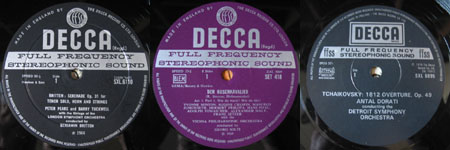
1. The early ‘wide band deep groove’ label – these are the most collectable of the Decca pressings and date from the late 50s to the mid to late 60s. The ‘deep groove’ is the circular indentation about 1cm from the edge of the label. Apparently this groove is caused by the conversion of old 78rpm pressing plants to the production of 33rpm LPs – the groove coincides with the label position of old 78s. Sound wise these are stunning, real valve technology stuff.
2. The slightly later ‘wide band’ (no deep groove). Still valve technology, this label design was used until about late 69 IIRC. The one pictured is a SET, hence the different colour (SETs are in most situations multi album boxes, though there are some exceptions). A very collectable label.
3. The 70s ‘narrow band’. Still good sounding records, but in most cases transistor technology was used. These are generally far less collectable than the earlier pressings unless the record was originally pressed on this design which is after SXL6449. There are however many collectable ‘narrow band’ SXLs and they are all very fine records.
Comments: The SXL series arrived in the late 50s, prior to which Decca’s prime range was the mono LXT. After the arrival of the SXL a given recording was often issued as both a mono LXT and a stereo SXL. With recordings prior to LXT 6xxx the stereo SXL counterpart, if it existed at all, had a seemingly unconnected number in the SXL 2xxx range. Decca later introduced the SXL6xxx range, and at this point the numbers directly coincided with the LXT numbers, i.e. LXT 6014 and SXL 6014 are the mono and stereo pressings of the same recording. As a sweeping generalisation 2000 series SXLs are worth more than 6000 series, but there are plenty of exceptions either way to this rule.
Interesting Decca spin-offs:
During the 1960s and 70s Decca had a bewildering variety of spin-off labels that ran alongside the premium SXL, there is much good music on these labels and the pressing quality is always up to Decca’s normal high standards – these all look physically similar to the 70s style SXL, i.e. slightly undersized label and beautiful high quality pressings. I’m sure they were pressed on the same machines.

1. Ace Of Diamonds. This was a budget label that usually reissued classic Decca recordings from the late 50s and 60s. Many of these recordings were originally issued as SXLs, and apparently the very same stampers were often used, so they can be a real genuine SXL on the cheap. Many exist in both deep groove and non-deep-groove formats and some very valuable SXLs are reissued in this format.
2. Decca Eclipse. I’m a bit confused by this label as many of the recordings seem to be mono ‘electronically enhanced for stereo’ (I don’t tend to buy these), but many are truly superb vintage stereo recordings.
3. Argo ‘oval’. Decca didn’t seem to have a clear musical genre or type of recording for Argo, the label seems to span everything from classical through spoken word plays (Shakespeare etc) through a wide variety of classical to folk. Note deep grove on this 1960s mono example. These can be very collectable.
4. Argo ‘boxed’. This design was introduced in around 1970 at the same time Decca changed the SXL label. This one is a stereo, note the different label colour.
5. Decca World Of Classics. Yet another reissue program for earlier recordings. Tends to be quite popularist in subject matter, but again many are classic vintage recordings and affordable so can be a great way of obtaining certain works.
6. Vox Turnabout. Classic recordings from the US Vox label pressed beautifully under license by Decca in the UK. Some really superb stuff on this label.
Deutsche Grammophon Gesellschaft:
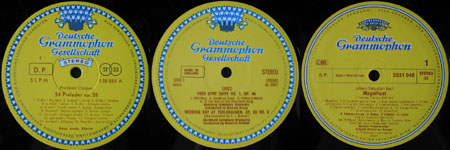
1. The German ‘tulip’ label. The original 50s and 60s DGG label design and very collectable. Being honest I have no idea which are the rare ones as my guide doesn’t cover them! The early German pressings are more sought after than the UK issues and are very heavy solid slabs of vinyl. Very good sound indeed.
2. The UK ‘tulip’. Second only to the German ones, nice solid pressings with good very sound.
3. The 70s ‘white rim’. Lighter weight and generally not as good sound, but there are many, many exceptions and a huge amount of wonderful music on this label. Not inherently collectable so good value and a great way of getting some good recordings. There are German and UK pressings of most of these, and to be honest I haven’t formed an opinion as to which are preferable – both are certainly good.
Comments: Bizarrely as the vinyl got thinner the covers got thicker, most ‘white rim’ DGG have lovely quality laminated sleeves whereas the ‘tulips’ had thin fragile matt finish covers that suffer from edge and ring wear. The ‘tulip’ boxes and librettos are better quality though, very heavy grade paper librettos and beautiful cloth bound boxes.
HMV ALP mono:
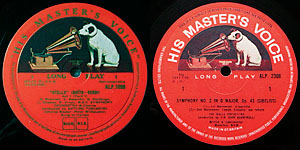
1. The ‘gold red’. The original and far more common ALP label.
2. ‘red semi’. Very rarely seen but of limited value to collectors. Still very nice records IMHO.
Comments: HMV’s entry into the long playing record market took place in 1952 with the first ALP. All the comments made above in relation to the Decca LXT apply to the ALP, they are nice sounding well pressed mono records and there are many desirable titles.
HMV ASD series:

1. The ‘white gold’. This label was the original design on ASDs up to ASD575 and is very sought after by collectors and many can command serious prices.
2. The ‘red semi’. HMVs 60s label design used from ASD576 onwards, again valve technology and good sound. A very collectable label.
3. The 70s ‘postage stamp’ (from ASD2484). Few have collectable value, but still some great music and an affordable way to get it. There are a few variations of this label, earlier ones have a coloured ‘Nipper’ in the postage stamp logo, later ones are black and white. As ever there is a hierarchy, anything released on one of the earlier designs is worth more in that format, but even so many rare and collectable recordings exist on these labels.
4. The ‘2nd semi’. This is an 80s label that can confuse inexperienced punters into believing they have a collectable ‘red semi’. No collectors value as such, and many of the recordings are digital.
Comments: There were two ASD series; the earlier had three digit numbers, the second had four, on the whole the earlier is the more valuable. Things become confusing with the four digit series once you factor the Melodya label into the equation, this was used for Russian recordings and the label design is different again – I have not included this label in the pics as I don’t have any to hand. Some are worth cash, many are not.
HMV Angel series:
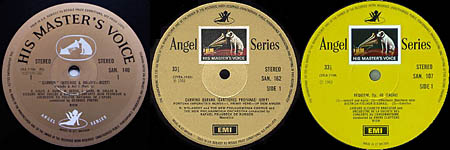
1. The ‘white angel’. This is a very collectable label and corresponds time wise to the white gold and red semi ASDs.
2. The ‘black angel’. A similar postage stamp design to 70s ASDs.
3. The ‘yellow’. A late period label where the bronze or gold background has been changed to a mustard yellow.
Comments: I’m not clear as to the selection process that meant a record came out on Angel rather than as an ASD. The Angel catalogue number has the prefix SAN and they are frequently referred to in this maner. Early examples are exceedingly collectable and can command very high prices. As ever collector logic applies and reissues of titles are worth incrementally less.
Mercury Living Presence:
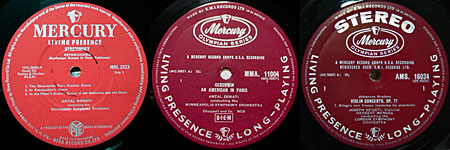
1. Pye pressed Living Presence MRL mono. I’ve not seen many of these. The sleeve is a one piece fully laminated affair with a large flip-back top and bottom, the words ‘Maroon Label’ appear under the MRL catalogue on the sleeve. The label on the only sample I had to hand was a far more red colour than the EMI issues as can be seen above.
2. EMI pressed Living Presence MML mono. Usually heavier grade two piece sleeves with three flip-backs and very nice quality vinyl. Some exist in early LXT style thin fully laminated one-piece sleeves with a top and bottom crescent flip-back. Note the label profile, there is an outer groove that I’ve not noticed on any EMI releases of this period. They all have it too.
3. EMI pressed Living Presence AMS stereo. Same comments apply to the EMI pressed stereo as to the mono with regard to label profile and sleeve style. These can be very collectable and valuable records indeed.
Comments: The UK issues of the classic US Mercury albums. The early stereo ones are legendary amongst audiophiles for their unique three mic technique and the corresponding punchy spacious sound. It’s all a bit swings and roundabouts as to which is better between original US and UK copies, the US ones tend to be a little more exciting and edge of seat but the UK ones tend to be pressed better, i.e. quieter vinyl etc.
Philips:

1. Philips ‘Minigroove’ mono. This one is a Dutch pressing, note Philips logo centre bottom.
2. ‘Hi-Fi Stereo’. Now these seem rare, I’ve only found one since I’ve been selling classical vinyl whereas I’ve turned up many wb/dg SXLs, blue silver SAXs, Living Stereos etc. A very nice record. This one is an English pressing, note Philips logo at top, Dutch ones have it at the bottom like the pictured ‘Minigroove’.
3. Mid 60s onwards. There are many different colours though I have yet to work out the significance (if any). 60s pressings have a heavier grade vinyl and an almost textured matt label that is usually, but not always maroon like this one. Note the flat label profile.
4. 70s / early 80s. Thinner and with a slight ridge to the outside of the label and once again turns up in several colour variations. This thinner 70s vinyl is also good, usually quiet and flat.
5. Final label. This one is a ‘Digital Classics’ though there are analogue ones too. Not collectable as such but still nice records.
Comments: Philips are IMHO the sleepers in the pack. They are hugely undervalued. Lovely quiet pressings, usually superb recordings and a lot of superb music. Philips mono, whilst lovely things and actually pretty scarce, have next to no value for some reason that honestly escapes me.
RCA:
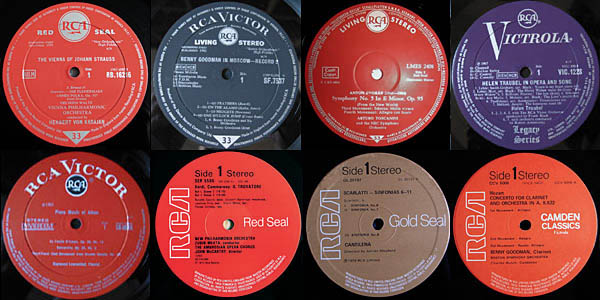
1. Decca pressed deep groove ‘silver spot’ mono. These can be very collectable if there is no corresponding Living Stereo and are also a good way of getting the music cheaply when there is.
2. Decca pressed deep-groove ‘silver spot’ Living Stereo. These are very collectable and good examples can command high prices, the one pictured is actually a jazz album, most classical ones have either red or black labels.
3. German ‘silver spot’ Living Stereo. Not as collectable as either the US or UK editions but still very nice records.
4. Decca pressed deep-groove RCA Victrola. These date from a similar time period as the Living Stereo recordings and are of a similar high quality, some are actually reissues of earlier Living Stereo titles. The catalogue number begins with the prefix ‘VIC’ for mono and ‘VICS’ for stereo. The one pictured is a 'Legacy Series' hence the additional logo at the bottom.
5. Decca pressed deep-groove RCA Victor SB series ‘black spot’. This is the label design replaced the ‘silver spot’ in the mid to late 60s. Some examples retain the Living Stereo wording. The quality remains exceptional.
6. RCA Red Seal. The main 70s label, not inherently collectable in itself, but very nice records and fine recordings nonetheless.
7. RCA Gold Seal. An alternative strand that existed in the mid to late 70s.
8. RCA Camden. RCA’s 70s budget reissue label that is a great way of getting hold of prime Living Stereo recordings for peanuts. Many of RCA’s highly regarded early stereo recordings got another outing here.
Comments: As with Mercury these were UK pressings of American recordings and similar views are held regarding respective quality, i.e. US ones are a little more punchy, UK ones quieter. The US RCAs were shipped in fairly harsh paper inners so tend to have picked up surface bruising / scuffing, UK ones shipped in quality poly inners though are subject to ‘sleeve transfer’ (where a gently rippled effect is present on the record surface) if they have got even slightly damp at any point.
This is very much a work in progress and will probably grow in content / change in shape over time. I have limited the scope so far to the more collectable / interesting UK and European pressings.
Columbia:

[left to right]
1. 33CX ‘blue gold’. Columbia entered the LP market in 1952 with the mono 33CX range and this is their first label design. Many collectable titles on this label. After 1958 it ran in conjunction with the SAX stereo label with many titles appearing in each format. A good way of getting copies of fiendishly expensive SAX titles.
2. 33CX ‘red semi’. Not as common as the original ‘blue gold’ design but not as collectable either. Still nice records.
3. SAX ‘blue silver’. An exceptionally collectable label, many titles routinely achieve prices well into the hundreds and they tend to be superb sounding records.
4. SAX ‘red semi’. If a title exists on a ‘blue silver’ then the red semi issue is worth radically less. Many titles were however released on this label and can command high prices. Very nice records indeed.
5. SAX ‘postage stamp’ or ‘boxed’. The 70s variation of the label, not collectable if the recording exists in an earlier design, but still nice records.
Comments: This is the UK Columbia label, not the US one (CBS in the UK).
Decca LXT mono:

Comments: Decca’s first venture into 12” long playing records ran from 1950 through until 1969. There are actually two label designs but they are incredibly similar, the lettering print is gold on the very earliest. After the introduction of stereo in 1958 most titles were released both in mono as an LXT and in stereo as an SXL. Where both titles exist the SXL is invariably more valuable, though there is a large number of titles that ae mono only. Some are worth serious collectors prices. The LXT, like Columbia’s 33CX and HMV’s ALP ranges, can be a very good way of obtaining titles which are prohibitively expensive and collectable in the stereo format. They tend to be nice sounding records.
Decca SXL and SET series:

1. The early ‘wide band deep groove’ label – these are the most collectable of the Decca pressings and date from the late 50s to the mid to late 60s. The ‘deep groove’ is the circular indentation about 1cm from the edge of the label. Apparently this groove is caused by the conversion of old 78rpm pressing plants to the production of 33rpm LPs – the groove coincides with the label position of old 78s. Sound wise these are stunning, real valve technology stuff.
2. The slightly later ‘wide band’ (no deep groove). Still valve technology, this label design was used until about late 69 IIRC. The one pictured is a SET, hence the different colour (SETs are in most situations multi album boxes, though there are some exceptions). A very collectable label.
3. The 70s ‘narrow band’. Still good sounding records, but in most cases transistor technology was used. These are generally far less collectable than the earlier pressings unless the record was originally pressed on this design which is after SXL6449. There are however many collectable ‘narrow band’ SXLs and they are all very fine records.
Comments: The SXL series arrived in the late 50s, prior to which Decca’s prime range was the mono LXT. After the arrival of the SXL a given recording was often issued as both a mono LXT and a stereo SXL. With recordings prior to LXT 6xxx the stereo SXL counterpart, if it existed at all, had a seemingly unconnected number in the SXL 2xxx range. Decca later introduced the SXL6xxx range, and at this point the numbers directly coincided with the LXT numbers, i.e. LXT 6014 and SXL 6014 are the mono and stereo pressings of the same recording. As a sweeping generalisation 2000 series SXLs are worth more than 6000 series, but there are plenty of exceptions either way to this rule.
Interesting Decca spin-offs:
During the 1960s and 70s Decca had a bewildering variety of spin-off labels that ran alongside the premium SXL, there is much good music on these labels and the pressing quality is always up to Decca’s normal high standards – these all look physically similar to the 70s style SXL, i.e. slightly undersized label and beautiful high quality pressings. I’m sure they were pressed on the same machines.

1. Ace Of Diamonds. This was a budget label that usually reissued classic Decca recordings from the late 50s and 60s. Many of these recordings were originally issued as SXLs, and apparently the very same stampers were often used, so they can be a real genuine SXL on the cheap. Many exist in both deep groove and non-deep-groove formats and some very valuable SXLs are reissued in this format.
2. Decca Eclipse. I’m a bit confused by this label as many of the recordings seem to be mono ‘electronically enhanced for stereo’ (I don’t tend to buy these), but many are truly superb vintage stereo recordings.
3. Argo ‘oval’. Decca didn’t seem to have a clear musical genre or type of recording for Argo, the label seems to span everything from classical through spoken word plays (Shakespeare etc) through a wide variety of classical to folk. Note deep grove on this 1960s mono example. These can be very collectable.
4. Argo ‘boxed’. This design was introduced in around 1970 at the same time Decca changed the SXL label. This one is a stereo, note the different label colour.
5. Decca World Of Classics. Yet another reissue program for earlier recordings. Tends to be quite popularist in subject matter, but again many are classic vintage recordings and affordable so can be a great way of obtaining certain works.
6. Vox Turnabout. Classic recordings from the US Vox label pressed beautifully under license by Decca in the UK. Some really superb stuff on this label.
Deutsche Grammophon Gesellschaft:

1. The German ‘tulip’ label. The original 50s and 60s DGG label design and very collectable. Being honest I have no idea which are the rare ones as my guide doesn’t cover them! The early German pressings are more sought after than the UK issues and are very heavy solid slabs of vinyl. Very good sound indeed.
2. The UK ‘tulip’. Second only to the German ones, nice solid pressings with good very sound.
3. The 70s ‘white rim’. Lighter weight and generally not as good sound, but there are many, many exceptions and a huge amount of wonderful music on this label. Not inherently collectable so good value and a great way of getting some good recordings. There are German and UK pressings of most of these, and to be honest I haven’t formed an opinion as to which are preferable – both are certainly good.
Comments: Bizarrely as the vinyl got thinner the covers got thicker, most ‘white rim’ DGG have lovely quality laminated sleeves whereas the ‘tulips’ had thin fragile matt finish covers that suffer from edge and ring wear. The ‘tulip’ boxes and librettos are better quality though, very heavy grade paper librettos and beautiful cloth bound boxes.
HMV ALP mono:

1. The ‘gold red’. The original and far more common ALP label.
2. ‘red semi’. Very rarely seen but of limited value to collectors. Still very nice records IMHO.
Comments: HMV’s entry into the long playing record market took place in 1952 with the first ALP. All the comments made above in relation to the Decca LXT apply to the ALP, they are nice sounding well pressed mono records and there are many desirable titles.
HMV ASD series:

1. The ‘white gold’. This label was the original design on ASDs up to ASD575 and is very sought after by collectors and many can command serious prices.
2. The ‘red semi’. HMVs 60s label design used from ASD576 onwards, again valve technology and good sound. A very collectable label.
3. The 70s ‘postage stamp’ (from ASD2484). Few have collectable value, but still some great music and an affordable way to get it. There are a few variations of this label, earlier ones have a coloured ‘Nipper’ in the postage stamp logo, later ones are black and white. As ever there is a hierarchy, anything released on one of the earlier designs is worth more in that format, but even so many rare and collectable recordings exist on these labels.
4. The ‘2nd semi’. This is an 80s label that can confuse inexperienced punters into believing they have a collectable ‘red semi’. No collectors value as such, and many of the recordings are digital.
Comments: There were two ASD series; the earlier had three digit numbers, the second had four, on the whole the earlier is the more valuable. Things become confusing with the four digit series once you factor the Melodya label into the equation, this was used for Russian recordings and the label design is different again – I have not included this label in the pics as I don’t have any to hand. Some are worth cash, many are not.
HMV Angel series:

1. The ‘white angel’. This is a very collectable label and corresponds time wise to the white gold and red semi ASDs.
2. The ‘black angel’. A similar postage stamp design to 70s ASDs.
3. The ‘yellow’. A late period label where the bronze or gold background has been changed to a mustard yellow.
Comments: I’m not clear as to the selection process that meant a record came out on Angel rather than as an ASD. The Angel catalogue number has the prefix SAN and they are frequently referred to in this maner. Early examples are exceedingly collectable and can command very high prices. As ever collector logic applies and reissues of titles are worth incrementally less.
Mercury Living Presence:

1. Pye pressed Living Presence MRL mono. I’ve not seen many of these. The sleeve is a one piece fully laminated affair with a large flip-back top and bottom, the words ‘Maroon Label’ appear under the MRL catalogue on the sleeve. The label on the only sample I had to hand was a far more red colour than the EMI issues as can be seen above.
2. EMI pressed Living Presence MML mono. Usually heavier grade two piece sleeves with three flip-backs and very nice quality vinyl. Some exist in early LXT style thin fully laminated one-piece sleeves with a top and bottom crescent flip-back. Note the label profile, there is an outer groove that I’ve not noticed on any EMI releases of this period. They all have it too.
3. EMI pressed Living Presence AMS stereo. Same comments apply to the EMI pressed stereo as to the mono with regard to label profile and sleeve style. These can be very collectable and valuable records indeed.
Comments: The UK issues of the classic US Mercury albums. The early stereo ones are legendary amongst audiophiles for their unique three mic technique and the corresponding punchy spacious sound. It’s all a bit swings and roundabouts as to which is better between original US and UK copies, the US ones tend to be a little more exciting and edge of seat but the UK ones tend to be pressed better, i.e. quieter vinyl etc.
Philips:

1. Philips ‘Minigroove’ mono. This one is a Dutch pressing, note Philips logo centre bottom.
2. ‘Hi-Fi Stereo’. Now these seem rare, I’ve only found one since I’ve been selling classical vinyl whereas I’ve turned up many wb/dg SXLs, blue silver SAXs, Living Stereos etc. A very nice record. This one is an English pressing, note Philips logo at top, Dutch ones have it at the bottom like the pictured ‘Minigroove’.
3. Mid 60s onwards. There are many different colours though I have yet to work out the significance (if any). 60s pressings have a heavier grade vinyl and an almost textured matt label that is usually, but not always maroon like this one. Note the flat label profile.
4. 70s / early 80s. Thinner and with a slight ridge to the outside of the label and once again turns up in several colour variations. This thinner 70s vinyl is also good, usually quiet and flat.
5. Final label. This one is a ‘Digital Classics’ though there are analogue ones too. Not collectable as such but still nice records.
Comments: Philips are IMHO the sleepers in the pack. They are hugely undervalued. Lovely quiet pressings, usually superb recordings and a lot of superb music. Philips mono, whilst lovely things and actually pretty scarce, have next to no value for some reason that honestly escapes me.
RCA:

1. Decca pressed deep groove ‘silver spot’ mono. These can be very collectable if there is no corresponding Living Stereo and are also a good way of getting the music cheaply when there is.
2. Decca pressed deep-groove ‘silver spot’ Living Stereo. These are very collectable and good examples can command high prices, the one pictured is actually a jazz album, most classical ones have either red or black labels.
3. German ‘silver spot’ Living Stereo. Not as collectable as either the US or UK editions but still very nice records.
4. Decca pressed deep-groove RCA Victrola. These date from a similar time period as the Living Stereo recordings and are of a similar high quality, some are actually reissues of earlier Living Stereo titles. The catalogue number begins with the prefix ‘VIC’ for mono and ‘VICS’ for stereo. The one pictured is a 'Legacy Series' hence the additional logo at the bottom.
5. Decca pressed deep-groove RCA Victor SB series ‘black spot’. This is the label design replaced the ‘silver spot’ in the mid to late 60s. Some examples retain the Living Stereo wording. The quality remains exceptional.
6. RCA Red Seal. The main 70s label, not inherently collectable in itself, but very nice records and fine recordings nonetheless.
7. RCA Gold Seal. An alternative strand that existed in the mid to late 70s.
8. RCA Camden. RCA’s 70s budget reissue label that is a great way of getting hold of prime Living Stereo recordings for peanuts. Many of RCA’s highly regarded early stereo recordings got another outing here.
Comments: As with Mercury these were UK pressings of American recordings and similar views are held regarding respective quality, i.e. US ones are a little more punchy, UK ones quieter. The US RCAs were shipped in fairly harsh paper inners so tend to have picked up surface bruising / scuffing, UK ones shipped in quality poly inners though are subject to ‘sleeve transfer’ (where a gently rippled effect is present on the record surface) if they have got even slightly damp at any point.

